|
The following sixteen species have been observed or recorded within the monument. Some are relatively common year-round, while others are only observed with specialized scientific equipment and during their seasonal migration. 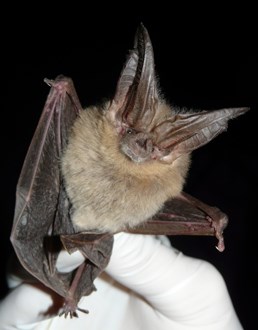
Photo by Zach Kaiser Townsend's Big-eared Bat (Corynorhinus townsendii) As their name implies, this species has unusually large ears that average a third of their body length and help them navigate using echolocation; they fly low and slow through lava trenches to catch moths for dinner. Two large lumps on their nose also help distinguish them from other species, and their fur is dark brown on the back and lighter on the belly. In the summer, maternal colonies cluster together in warm caves to raise their pups; in winter they hibernate in cold caves where the temperature is more stable, sometimes roosting by themselves or in small groups and sometimes in large clusters. Townsend's Big-eared Bats use their large ears for thermoregulation; often the bats in the middle of a cluster will have both ears extended to cool off, while bats toward the edge of the cluster or roosting by themselves will tuck both ears underneath their wings to stay warm. Solitary bats will sometimes hang by only one foot. 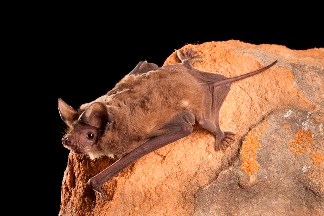
Photo copyright Michael Durham/Minden Pictures/Bat Conservation International Brazilian Free-tailed Bat (Tadarida brasiliensis) Named for the way their tail is longer than the membrane of skin between their feet, these bats migrate all the way to southern Mexico and Central America for the winter. Females return to Lava Beds by the tens of thousands and live in remote caves in the monument to raise their young in the summer. They consume tons of insects over the marshes and fields of the Tule Lake Basin and are a great benefit to local agriculture. Amazingly, mothers can locate their pups among the thousands, and sometimes millions, of bats in a maternal colony by smell and sound. Bracken Cave in Texas provides habitat for 20 million Brazilian Free-tailed Bats each summer, making it the largest concentration of mammals in the world. 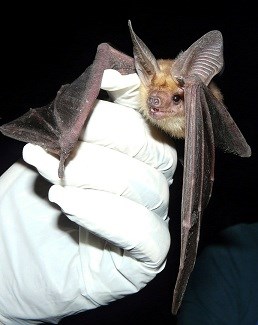
Photo by Zach Kaiser Pallid Bat (Antrozous pallidus) Among the largest of the bat species found in the area, the Pallid Bat weighs 20-35 grams, making them more than double the size of the Townsend's Big-eared Bat. The ears of the Pallid Bat are an average of nearly half its body length. Other distinguishing characteristics include blonde body fur, large eyes, a strong, musky odor, and a prominent, blunt snout. Pallid Bats do not migrate, so roost and hibernacula sites are chosen from within the same general area. Pallid Bats are unique in their foraging habits compared to other North American bats; they often walk along the ground and can hover or glide to catch their prey. They are immune to scorpion stings, as these are one of their favorite prey items. They are also listed as one of only 10 confirmed carnivorous bat species in the world as they occasionally eat small vertebrates such as lizards and rodents. The wings of a pallid bat are very thick and tough compared to other bat species and often have many scars from being ripped up by vegetation while searching for food on the ground. 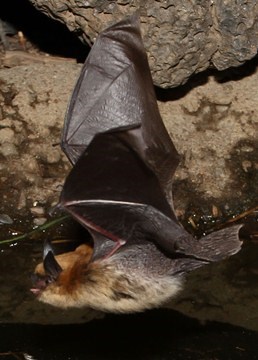
Photo by Norm Barrett Big Brown Bat (Eptesicus fuscus) Abundant throughout North America and the southern reaches of Canada, this species is more familiar to Americans than any other bat as roosting locations are closely associated with human structures. In the warmer months, they can be found roosting in attics, barns, garages, and most other man-made buildings. Only during the coldest weather can they be found hibernating underground in caves and mines. Where the majority of them migrate during the winter is unknown. Bats of this species will bear a single offspring in the Western United States, but will generally raise twins in the Eastern United States. Though White-nose Syndrome has not yet reached Lava Beds National Monument, Big Brown Bats are affected by this deadly disease in the eastern United States and Canada. 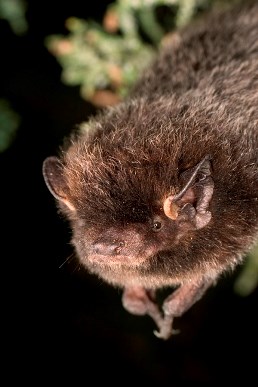
Photo copyright Michael Durham/Minden Pictures/Bat Conservation International Silver-haired Bat (Lasionycteris noctivagans) An exception to the rule, females of this tree-roosting species usually give birth to twins (most other species give birth to only one pup each year). Relatively slow flyers, silver-haired bats forage 20-25 feet above ground over woodland ponds and streams. They emerge earlier in the evening than many other species to consume moths, true bugs, flies, mosquitoes, termites, and beetles. This species migrates into the Northern U.S. and Canada to raise their pups in the summer and heads south for the winter. Their slow flight, silver tipped fur, and large size distinguish them from other bat species. 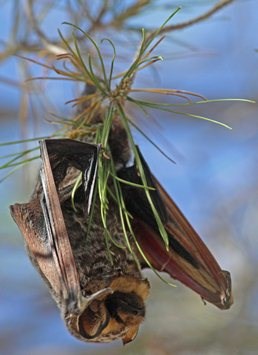
Photo by Norm Barrett Hoary Bat (Lasiurus cinereus) A species that you will not find in a cave, these large furry bats live in forests and roost in trees. They are widespread over North America and up to the mid-regions of Canada, and are the only species of bat in Hawaii. They live generally solitary lives and are very hard to find. The sexes are geographically separated during the summer months and northern populations migrate south to warmer climates in the winter. Hoary bats will typically bear twins during the spring and early summer, deviating from the standard one offspring a year for most bats. This species has been seen foraging up to 8,000 feet above ground and primarily eats insects, but may prey on smaller bats. Their large size (25-30 grams), shimmering fur, and colorful wings make them easily recognizable from most other bats. 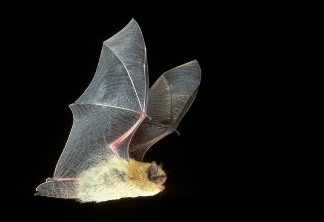
Photo copyright J. Scott Altenbach California Bat (Myotis californicus) Among the smallest species occurring in the monument, this 3-5 gram bat can be found along the pacific coastline, reaching east to Idaho and Utah and up to the southern regions of Alaska. Favored feeding grounds include the edge of wooded areas, over sources of water, and high above the ground in open areas. During summer when females are rearing young, males roost separately and join the females only from September to March. Favored roosting locations include loose spaces under bark, hollow trees, rock crevices, and buildings. Distinguishing this species from the Western Small-footed Bat can be difficult due to their similar coloration. 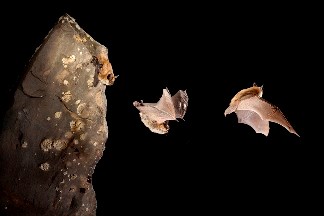
Photo copyright Michael Durham/Minden Pictures/Bat Conservation International Western Small-footed Bat (Myotis ciliolabrum) Much like other bats of the genus Myotis, this bat averages a very small size of 4-6 grams. Coloration of the Western Small-footed Bat is a yellowish on its backside and nearly white on its underbelly, though it is difficult to tell apart from the California Bat (Myotis californicus). Western Small-footed Bats roost and hibernate in small colonies of 2-6 individuals in rock crevices, stream banks, caves, under loose tree bark, and in buildings. Preferring to feed over sources of water, they can be found dipping down to drink and feeding on insects around ponds, streams, and man-made water sources. Uncommon for other bats, this species is known to thoroughly chew its food before swallowing. 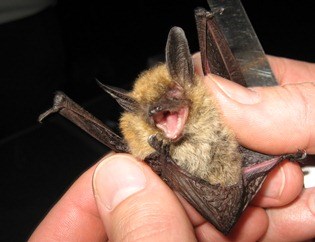
Photo by Katrina Smith Long-eared Bat (Myotis evotis) Similar in appearance to other Myotis species, these bats can be distinguished by their namesake long ears which extend beyond the nose when folded down over their face. The Long-eared Bat is a nimble species that can be seen foraging for insects in and around trees and over water. The habitat range for this species includes the Western United States up to southwestern Canada and down to Baja California, Mexico. They have a preference for roosting in forested areas but can also be found in more arid locations. Roost sites vary greatly and include spaces underneath loose tree bark and inside hollow trees to crevices in cliff faces and inside caves and mines. Lifespan for these bats has been recorded at 22 years, and females give birth to one pup each summer. 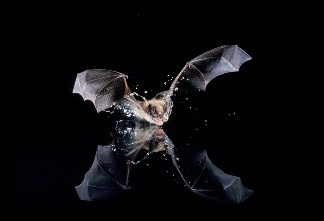
Photo copyright J. Scott Altenbach Long-legged Bat (Myotis volans) This western species roosts in trees and rock crevices in mostly forested, mountain areas during the summer, though caves and mines are often chosen as hibernation sites for the winter. Long-legged Bats are quick fliers known to chase prey for relatively long distances and are particularly good at flying in cool temperatures, which may allow them to delay their hibernation period. Their diet consists mostly of moths, but other soft-bodied insects may also be consumed. The lifespan of this species may reach up to 21 years. 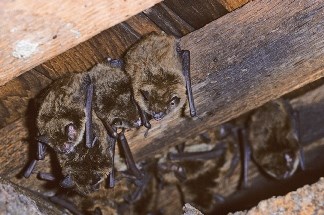
Photo copyright Donna Hensley, Bat Conservation International, www.batcon.org Little Brown Bat (Myotis lucifugus) Ironically, the Little Brown Bat is the largest bat of the genus Myotis occurring in the monument, reaching a weight of 7-14 grams. They can be found throughout much of the United States and Canada. Hibernation during the winter takes place in caves and mines, but in summer these bats are often found in buildings where maternal colonies number from the hundreds to thousands; while roosting during the day, mothers hold their babies underneath their wing. Preferring to feed over sources of water, these bats use their wings and tail membrane to scoop insects into their mouth in mid-flight. Though White-nose Syndrome has not yet reached Lava Beds National Monument, little brown bats are severely affected by this deadly disease in the Eastern United States and Canada and may soon be listed as threatened or endangered. 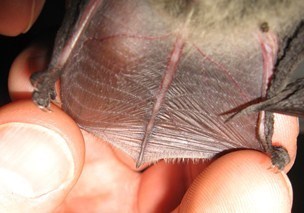
Photo by Katrina Smith Fringed Bat (Myotis thysanodes) These bats are unique from other species in that their tail membrane is lined with a fringe of short hairs, visible in this photo. Inhabiting the Western United States and Mexico, this small bat of 5-7 grams can be seen foraging for beetles and moths in the tree canopy. Their flight is slow which gives them better maneuverability. Fringed bats are particularly sensitive to temperature and will relocate roost sites to adjust for excessive heat or cold. Newborn pups are placed together in a group separate from adults and will only be joined by the parent to feed. It is known that fringed bats migrate, but to where and how far is yet to be discovered. 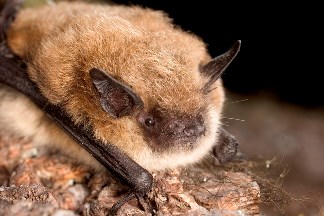
Photo copyright Michael Durham/Minden Pictures/Bat Conservation International Yuma Bat (Myotis yumanensis) Ranging through Western North America from southwest Canada to Mexico, the Yuma Bat is almost exclusively found inhabiting locations near open water, where they choose to hunt for beetles and soft-bodied insects such as flies, termites, and moths. Like many other bat species, male Yuma Bats live a mostly solitary lifestyle, only joining females to mate in the fall. Female Yuma Bats can bear young when they are just one year old, and will each raise a single pup in maternal colonies during the summer. Yuma bats are very similar in appearance to Little Brown Bats (Myotis lucifugus) and are often only distinguishable by their echolocation calls. 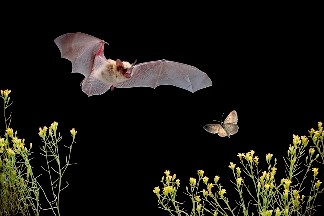
Photo copyright Michael Durham/Minden Pictures/Bat Conservation International Canyon Bat (Parastrellus hesperus) The Canyon Bat is one of the smallest species in the monument, with an average body weight of 3-6 grams. These bats are typically found in arid locations and are common throughout the Southwestern U.S. Perhaps the weakest flier of North American bats, this species can be halted by just a slight breeze and forced to find shelter in stronger winds. Peculiar in comparison to most bats, this species prefers to forage for insects quite early in the evening and typically returns to the roost within an hour or two after sunset, and may forage again after dawn. Lactating females are the exception to this rule, as they may remain active during most of the night. The genus of this species was changed recently, so you might still hear these bats referred to as the Western Pipistrelle, though the Canyon Bat is the currently accepted common name. 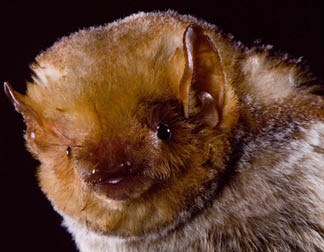
Photo by Merlin Tuttle Western Red Bat (Lasiurus blossevillii) This beautiful mammal is a “tree bat”, meaning it roosts in trees instead of in caves, cliff faces, or talus slopes like many other bats at Lava Beds. This is a medium-sized bat with weight equivalent to six pennies (11-14 grams) with a wingspan of 11-13 inches and a lifespan of up to 12 years. Their dense fur ranges from brownish yellow to a bright orange with frosty white tips. This unique color provides camouflage in tree roosts as they resemble dead leaves when curled up in their furry tail membranes to rest. Like most tree bats this species is solitary, coming together only to mate and to migrate. Their diet consists of flying insects such as moths, flying ants, and beetles. Though typically found in riparian areas like California’s Central Valley, the edges of their range are not well documented. This species has only been detected by acoustic monitoring within Lava Beds, but one was captures at a site just a few miles south of the park during in 2016. 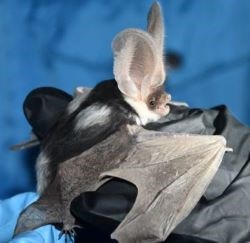
NPS A newly recorded bat migrating through the park, these widely distributed but somewhat rare bats prefer either cliffs or trees for their roosts. |
Last updated: January 21, 2024
